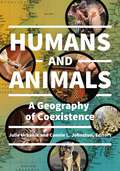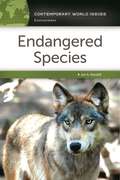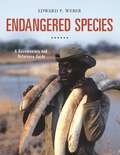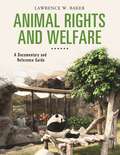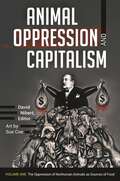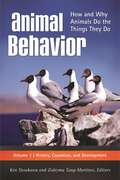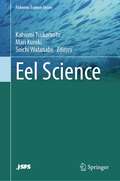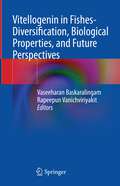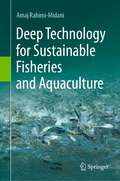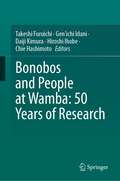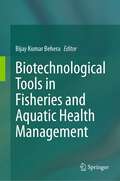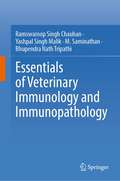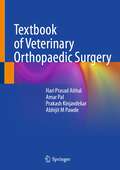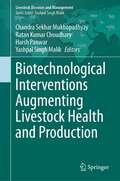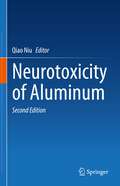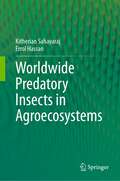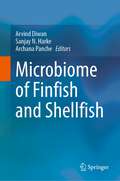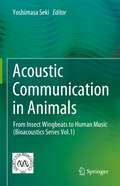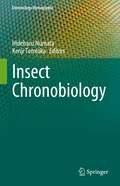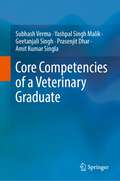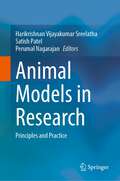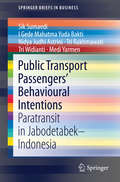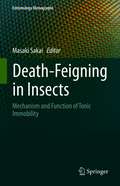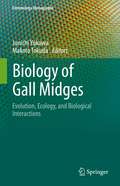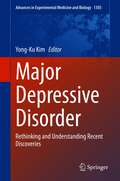- Table View
- List View
Humans and Animals: A Geography of Coexistence
by Julie Urbanik and Connie L. Johnston, EditorsAn engaging and at times sobering look at the coexistence of humans and animals in the 21st century and how their sometimes disparate needs affect environments, politics, economies, and culture worldwide.There is an urgent need to understand human-animal interactions and relations as we become increasingly aware of our devastating impact on the natural resources needed for the survival of all animal species. This timely reference explores such topics as climate change and biodiversity, the impact of animal domestication and industrial farming on local and global ecosystems, and the impact of human consumption of wild species for food, entertainment, medicine, and social status. This volume also explores the role of pets in our lives, advocacy movements on behalf of animals, and the role of animals in art and media culture. Authors Julie Urbanik and Connie L. Johnston introduce the concept of animal geography, present different aspects of human-animal relationships worldwide, and highlight the importance of examining these interconnections. Alphabetical entries illustrate key relationships, concepts, practices, and animal species. The book concludes with a comprehensive appendix of select excerpts from key primary source documents relating to animals and a glossary.
Endangered Species: A Reference Handbook (Contemporary World Issues)
by Jan A. RandallA detailed exploration of the variety of threats that endangered species are facing around the world, whether they are due to human impact or so-called natural causes.Endangered species is a more complex issue and problem than it may seem on the surface. What species are endangered, and what is causing them to become vulnerable to population decline? How can essential industries such as farming, housing development, and manufacturing continue to thrive without harming flora and fauna that are protected? Are current efforts adequate or should more be done to protect endangered species? And who should be responsible for the substantial costs of working to save endangered species?Endangered Species: A Reference Handbook begins with an introduction that addresses major threats and extinctions in history, discusses the geographical and cultural contexts in which these incidents happened, highlights other key moments along the endangered species timeline, and clearly shows why the topic of endangered species matters. The following sections examine an unbiased synthesis of classic and contemporary studies that inform the issue of endangered species and outline the most controversial events related to endangered species and the actions that have been taken to address them. The book also presents perspective essays by scholars, activists, and other experts to provide diverse informed opinions on the issue of endangered species and includes a data and documents chapter that applies research finding to provide answers to questions like what species are most likely to become endangered in the future and which practices have historically been the most effective at protecting vulnerable species.
Endangered Species: A Documentary and Reference Guide (Documentary and Reference Guides)
by Edward P. WeberThis book uses primary documents as a lens through which to examine historical and present-day efforts to protect endangered species in the United States and around the world.In this thought-provoking work, author Edward P. Weber examines the values, policies, challenges, and approaches to endangered species conservation over the past 200 years. Using primary source documents and in-depth analysis of the issues, the reference tracks the evolution of species protection and conservation in the United States, and offers a brief look at global programs in the United States and other parts of the world. The book surveys how different countries are faring in protecting their plant and animal life, and considers which guidelines and programs hold the most promise for success in the future. Chapters compare and contrast past and present attitudes regarding endangered species and extinction and identify the influence of major organizations and individuals central to the debate over endangered species. Judiciously selected primary documents also explore the impact of species endangerment and loss on natural ecosystems—and ultimately, on humankind itself.
Animal Rights and Welfare: A Documentary and Reference Guide (Documentary and Reference Guides)
by Lawrence W. BakerThrough the use of primary source documents, readers can learn about key opinions and legislation in the important field of animal rights and welfare—a current and highly relevant topic.Animal Rights and Welfare: A Documentary and Reference Guide addresses a broad range of key topics within the subject of animal rights and welfare, including zoos, animal testing, philosophy regarding the treatment of animals, and practical measures instituted to protect animals, supplying readers with an impartial and authoritative resource for understanding the history of animal rights and the issues that dominate discussions about animal rights. Organized chronologically, the book discusses topics such as animal rights within the context of hunting for food, pelts, and other body parts, as well as for recreation; working animals; animals used for education or scientific and medical research; animals in the fashion and entertainment industries; and the food industry.The text provides reproductions of dozens of carefully selected primary documents from the time of Aristotle (B.C.) to present day to engage readers and provide opportunities for them to apply their critical thinking and analysis skills. The text of each document is introduced by a headnote to place it in context and concludes with analysis that details its significance and clarifies specific passages when needed. Each document or excerpt is followed by a full citation of the document.
Animal Oppression and Capitalism [2 volumes]: [2 volumes] (Critical Perspectives On Animals: Theory, Culture, Science, And Law Ser.)
by David NibertThis important two-volume set unapologetically documents how capitalism results in the oppression of animals ranging from fish and chickens to dogs, elephants, and kangaroos as well as in environmental destruction, vital resource depletion, and climate change.Most traditional narratives portray humanity's use of other animals as natural and necessary for human social development and present the idea that capitalism is generally a positive force in the world. But is this worldview accurate, or just a convenient, easy-to-accept way to ignore what is really happening—a systematic oppression of animals that simultaneously results in environmental destruction and places insurmountable obstacles in the path to a sustainable and peaceful future?David Nibert's Animal Oppression and Capitalism is a timely two-volume set that calls into question the capitalist system at a point in human history when inequality and the imbalance in the distribution of wealth are growing domestically and internationally. Expert contributors show why the oppression of animals—particularly the use of other animals as food—is increasingly being linked to unfavorable climate change and the depletion of fresh water and other vital resources. Readers will also learn about the tragic connections between the production of animal products and global hunger and expanded regional violence and warfare, and they will understand how many common human health problems—including heart attacks, strokes, and various forms of cancer—develop as a result of consuming animal products.
Animal Behavior [3 volumes]: How and Why Animals Do the Things They Do [3 volumes]
by Alison M. Bell Andrew P. King Anna Dornhaus Anne Danielson-François Anthony C. Little Benedict C. Jones Bennett G. Galef Brett M. Gibson Brian Keane Bronwyn H. Bleakley Çağlar Akçay Carolynn L. Smith Catherine A. Marler Charles T. Snowdon Christopher D. Watkins Christopher Harshaw Christopher S. Evans David B. Mcdonald David Clark David Crews David F. Sherry David J. White Douglas W. Mock Geoffrey E. Hill George Uetz Guillermo Paz-Y-Miño-c James L. Gould Janis L. Dickinson Jason Low Jeffrey R. Alberts Ken Yasukawa Kenyon B. Mobley Laura Smale Lee Alan Dugatkin Lee C. Drickamer Lisa M. Debruine Mark E. Hauber Matthew J. Fuxjager Megan Hastings Hagenauer Meredith J. West Michael D. Beecher Michael J. Ryan Michelle Pellissier Scott Nancy G. Solomon Rachel A. Page Renée A. Duckworth S. Craig Roberts Sarah Jane Alger Sean P. Bradley Terry J. Ord Theodore Stankowich Walter D. Koenig Ximena E. Bernal Zenobia Lewis Zuleyma Tang-MartínezDiscover why animals do what they do, based on their genes, physiologies, cultures, traditions, survival and mating advantages, and evolutionary histories—and find out how studying behavior in the animal world helps us understand human behavior.The three volumes of Animal Behavior: How and Why Animals Do the Things They Do cover the breadth of the field, addressing causation, development, function, and evolution in a wide range of animals, from invertebrates to humans. Inspired by Nobel laureate Nikolaas Tinbergen's work, the first two volumes follow Tinbergen's four classic questions of animal behavior, while the third volume supplies integrated examples of Tinbergen's investigative process applied in specific cases.Written in an engaging, accessible manner ideal for college students as well as general audiences, this evidence-based collection provides a fascinating tour of animal behaviorists' findings, such as how animal communication can be truthful or deceitful, the deadly serious business behind clashes in the "battle of the sexes," and how documentation of animal behavior can lead to a deeper understanding of human behavior. Each chapter provides both historical background and information about current developments in animal behavior knowledge.
Eel Science (Fisheries Science Series)
by Katsumi Tsukamoto Mari Kuroki Soichi WatanabeThis book is a compilation of eel research and fish migration studies for more than 40 years showing the research history and recent advances in eel studies. Dr. Katsumi Tsukamoto, the esteemed editor of this book, has been actively involved in eel research as one of the leading scientists in the world for a long time, and he and his team successfully collected the fertilized eggs and spawn-condition adult eels from the wild for the first time in the world. This book compiles the essentials of the scientific findings obtained by the editor and his colleagues and reviews the latest references of eel science. Knowledge and information in the book such as a spawning area survey, research on artificial production of glass eels, the discovery of a new species, etc. will attract the reader’s interest, as these are written based on the authors’ experiences. Readers can obtain a comprehensive understanding of eels from various aspects of eel science including the cultural and socio-economic importance of eels and valuable scientific information using state-of-the-art approaches. The book also endeavors to contribute to the conservation of eel species, some of which have been classified as endangered by the IUCN and to promoting harmonious coexistence between humans and nature.
Vitellogenin in Fishes- Diversification, Biological Properties, and Future Perspectives
by Vaseeharan Baskaralingam Rapeepun VanichviriyakitThis book provides basic and advanced information on vitellogenin in fish. The proposed book discusses the history of vitellogenin, previtellogenesis, their diversification and classification in fishes, and tools for their identification and characterization. Further, their functional aspects in oogenesis and its regulatory mechanism, role as the immunocompetent molecule, and reproductive strategies are discussed. The book further examines vitellogenin as a hormone and biomarker, its related egg yolk proteins, and its mechanism on molecular cloning and induction. In addition, the book discusses its role in the disruption of the endocrine system in fish, its biological activities, its multivalent mechanism in marine and freshwater fishes, and its impact on the growth of ornamental fishes. Moreover, this book elaborates on the multiple vitellogenin genes, each with unique promoter regions and varying sensitivity to induction by estradiol, and multiple Vtg proteins themselves, with variable degrees of post-translational modification. As such, this book is helpful for researchers and students interested in the reproduction of fishes and reproductive biology.
Deep Technology for Sustainable Fisheries and Aquaculture
by Amaj Rahimi-MidaniThis book uses real-world examples from the aquaculture industry to demonstrate how deep technology is assisting farmers and vulnerable communities. Works conducted by Poseidon-AI (a deep tech company involved in the aquaculture sector) in different countries are presented as case studies to show the positive impacts of deep tech involvement in the aquaculture sector. Primary industries, such as fisheries and aquaculture, rely heavily on labor. Furthermore, the manual practices of these farming methods increase material waste and reduce yields, resulting in higher costs and lower revenues. Poikilotherms make up the majority of aquatic animals, and environmental changes have a significant impact on them. This means that, due to climate change, farming of these animals cannot continue in the same way that it has for centuries. Artificial intelligence, machine learning, image processing, sensing, and automation are approaches that can assist these farms in dealing with rapid environmental changes while also assisting farmers in growing their businesses sustainably. This book is of interest to climate change scientists, entrepreneurs, investors, civil workers, and policymakers. Furthermore, the book is a great complimentary material for graduate students of fisheries, aquaculture, ecology, soil science, water management and environmental sciences. All national and international policymakers working in implementation of UNSDGs and sustainability, will find this book a useful read.
Bonobos and People at Wamba: 50 Years of Research
by Takeshi Furuichi Gen'Ichi Idani Daiji Kimura Hiroshi Ihobe Chie HashimotoThis book reviews all the findings about bonobos and the local people of Wamba village in the Luo Scientific Reserve in the Democratic Republic of the Congo over the last 50 years. In 1973, Takayoshi Kano, a Japanese primatologist, traveled across a vast area of the Congo Basin with a bicycle and found Wamba village to be a promising site to start his first studies on wild bonobos. Since then, many researchers from Japan and all over the world have been working at Wamba, now the longest standing study site, to uncover various aspects of the ecology and behavior of this most recently identified great ape species. The researchers study bonobo behaviors and carry out various activities for the conservation of bonobos. They also conduct anthropological studies of local people who live with bonobos and believe them to be distant relatives from the same family, living in the forest. This book is published in commemoration of 2023 marking the 50th year of study. The main chapters are contributed by active researchers studying bonobos and the local people at Wamba. The book also includes contributions from various eminent researchers who have carried out short-term research or have supported research at Wamba, which helps place these studies of bonobos in a broader primatological or anthropological perspective. This book will be a useful resource for professional researchers in primatology and anthropology, as well as graduate or undergraduate students interested in these research fields.
Biotechnological Tools in Fisheries and Aquatic Health Management
by Bijay Kumar BeheraThis edited book is focused on SDG 14: life below water. This book covers all aspects of fish biotechnology and health management. A detailed description is provided of CRISPR Cas9 technology application in the development of superior variety of fish with better growth, disease resistance, etc., accompanied by numerous helpful photographs and schematic diagrams. In addition, recent developments in nanotechnology and its application in fisheries production enhancement have been discussed. Further, topics includes, probiotics, immunostimulants, fish genetic markers, bioremediation, metagenomics, transgenerational immune priming, application of cell culture in fisheries and nano-biosensor application on fish disease diagnosis, pollution monitoring, etc. are provided in details. . The book is helpful for researchers, teachers, students, farmers, and entrepreneurs in utilizing the knowledge on recent advancements in different aspects of fish genetics and biotechnology for future research and aquaculture production enhancement.
Essentials of Veterinary Immunology and Immunopathology
by Ramswaroop Singh Chauhan Yashpal Singh Malik M. Saminathan Bhupendra Nath TripathiTextbook of Veterinary Orthopaedic Surgery
by Hari Prasad Aithal Amar Pal Prakash Kinjavdekar Abhijit M PawdeThis textbook emphasizes the fundamentals of bone fracture and its fixation, including advanced techniques of osteosynthesis in both small and large animals. Various fracture fixation techniques and devices have been described in simple language with the help of sketches and photographs. The chapter on the basic considerations in fracture fixation narrates bone structure and types, bone development and growth regulation, types of fracture and fracture healing, first aid and emergency treatment, selection of fracture fixation technique, anesthetic management, and fracture fixation implants and instruments. The book highlights principles of different external, internal, and external skeletal fixation techniques. It also presents various basic and advanced techniques used to manage specific fractures in different bones, separately for small and large animal patients. It also includes specific topics like fracture fixation in young, osteoporotic, and avian bones, open fracture management, bone grafts and scaffolds, and fracture fixation complications. Towards the end, the book elucidates miscellaneous but essential topics in veterinary orthopedics such as metabolic bone diseases, antebrachial bone deformities, joint luxations, arthritis, common tendon, and ligament injuries, bone tumors, and physiotherapy and rehabilitation of patients. This textbook is essential reading for veterinary students, practitioners, and researchers working in veterinary orthopedic surgery.
Biotechnological Interventions Augmenting Livestock Health and Production (Livestock Diseases and Management)
by Chandra Sekhar Mukhopadhyay Ratan Kumar Choudhary Harsh Panwar Yashpal Singh MalikThis book comprehensively discusses the applications of molecular genetics, functional and structural genomics, and proteomics vis-a-vis bioinformatics, artificial intelligence, and robotics in livestock healthfulness and productivity. It reviews the biotechnological approaches in veterinary sciences for increasing productivity and resistance to disease. The book emphasizes the approaches based on artificial intelligence to analyze the data collected on animals, pathogens, and their environment. It underscores artificial intelligence applications in disease diagnosis, epidemiological studies, and detecting biological phenomena, including heat-detection, pregnancy, docility, and infections. Further, the book examines the genomics and proteomics approaches for understanding the gut microbiota and the role of pathogen-host interactions in animal health and disease. Lastly, it explores both pathogenic and non-pathogenic microbial transfer between humans, animals, and the environment across one health spectrum.
Neurotoxicity of Aluminum
by Qiao NiuThis book reviews the scientific literature and the authors’ own research linking aluminum neurotoxicity with cognitive impairment and Alzheimer’s disease (AD). It focuses on aluminum levels in the brain, region-specific and subcellular distribution, its relation to neurofibrillary tangles and amyloid beta—the pathological features of AD, and the possible mechanism of aluminum inducing these pathological features. Further, the book stresses the importance of aluminum’s complex speciation chemistry in relation to biology, and details aluminum’s mechanism in oxidative stress and cell death, especially in connection with apoptosis and necroptosis. The electrophysiological variation and synaptic plasticity induced by aluminum are covered, while the metal’s debatable role in AD and the cross-talk between aluminum and genetic susceptibility are also discussed, and more recently the relationship between aluminum-induced epigenetic modification on DNA and non-coding RNAs and neuron death and synaptic impairment.The second edition updates eight chapters according to the most recent researches. Content about aluminum-induced AD-like pathological features, neurotoxic effects of aluminum and aluminum alloy nanoparticles(TBD) and alumina nanoparticles induced neurotoxic and neurodevelopmental toxic effects is also added. In closing, this book provides readers with a systematic summary of aluminum neurotoxicity.
Worldwide Predatory Insects in Agroecosystems
by Kitherian Sahayaraj Errol HassanThis book brings out the world record of various predatory insects and their role in pestiferous insect management in a safer manner. The main focus of the book is to address the ecological and environmentally safe methods of managing pests of various crops. The utilization of various types of chemical pesticides for our crop protection and food production leads to environmental concerns and health hazards to plants and animals. This book mainly focuses on the distribution and diversity of various predatory insects in different crops. It also sellout the bionomics, biological control potential at a laboratory, controlled fields and natural conditions. Moreover, mass production technology and environmental safety aspects are also highlighted in various chapters. This book is of interest and useful to undergraduates, post-graduates, research scholars and doctoral candidates, extension workers, and agricultural professionals, and also a valuable source of reference to the relevant researchers and students in the region.
Microbiome of Finfish and Shellfish
by Arvind Diwan Sanjay N. Harke Archana PancheThis book helps us to understand the importance of the microbiome associated with finfish and shellfish inhabiting different locations and varied environmental and biological situations. It covers modern molecular tools for identifying microbiome composition and their precise identification at the species level. The book also covers the molecular structural composition of individual microbes, metabolite resources from microbiome species, their functional properties, and production aspects. Notable, the book covers the microbiome applications in the gut systems of finfish and shellfish to the digestion, nutrition, growth, reproduction, immune system, and vulnerability of the host to diseases. It also reviews diversity and functional properties, relationships with diseases, health status, data on species-specific metagenomics, and probiotic research. It highlights the relevance of microbial communities for the development of new and innovative bio-products to build bio and pharmaceutical industries, including aquaculture. This book is an invaluable source for researchers and professionals involved in fishery science, fisheries and aquaculture, fish biotechnology, and fish microbiology and pathology
Acoustic Communication in Animals: From Insect Wingbeats to Human Music (Bioacoustics Series Vol.1)
by Yoshimasa SekiThis book is the first volume of the bioacoustics series published by the Society for Bioacoustics. This volume provides an overview of the advances and recent topics in acoustic communication in various animals. Most animals produce vibrations and sounds by moving their body parts, including vocal organs. These sounds can be research targets of bioacoustics studies. How animals use these sounds, especially in inter-individual relationships, is the focus of this volume, “Acoustic Communication in Animals”. The authors’ expertise varies from molecular biology, neurobiology to psychology, and human brain imaging. Their research subjects range from invertebrates to humans. Despite the variety of topics, chapters are developed under the consideration of ethology and evolution. Readers will recognize the profundity of the topics in each chapter. In addition, the view and understanding of natural sound sequences produced by animals can vary among different cultures. Research from Japan and regions that have been underrepresented in previous literature can offer new ideas and unique perspectives in the study of bioacoustics. Readers can grasp the progress of this research field in a broad range of species in one book. The book presents multi- and interdisciplinary topics and appeals to researchers and students in fields including psychology, physiology, zoology, ethology, and neurosciences.
Insect Chronobiology (Entomology Monographs)
by Hideharu Numata Kenji TomiokaThis book reviews the physiological mechanisms of diverse insect clocks, including circadian clock, lunar clock, tidal clock, photoperiodism, circannual rhythms and others. It explains the commonality and diversity of insect clocks, focusing on the recent advances in their molecular and neural mechanisms. In the history of chronobiology, insects provided important examples of diverse clocks. The first report of animal photoperiodism was in an aphid, and the time-compensated celestial navigation was first shown in the honeybee. The circadian clock was first localized in the brain of a cockroach. These diverse insect clocks also have some common features which deserve to be reviewed in a single book. The central molecular mechanism of the circadian clock, i.e., the negative feedback loop of clock genes, was proposed in Drosophila melanogaster in the 1990s and later became the subject of the Nobel Prize in Physiology or Medicine in 2017. Thereafter, researches on the molecular and neural mechanisms in diverse insect clocks other than the Drosophila circadian clock also advanced appreciably. Various new methods including RNAi, NGS, and genome editing with CRISPR-Cas9 have become applicable in these researches. This book comprehensively reviews the physiological mechanisms in diverse insect clocks in the last two decades, which have received less attention than the Drosophila circadian clock. The book is intended for researchers, graduate students, and highly motivated undergraduate students in biological sciences, especially in entomology and chronobiology.
Core Competencies of a Veterinary Graduate
by Subhash Verma Yashpal Singh Malik Geetanjali Singh Prasenjit Dhar Amit Kumar SinglaThis book is an essential guide for veterinarians, veterinary faculty and policymakers for understanding the core competencies of a fresh veterinarian. The book briefly covers competencies in preclinical, paraclinical, and clinical subjects including anatomy, physiology, biochemistry, veterinary jurisprudence, animal management & welfare including nutrition and breeding, infectious and non-infectious diseases, disease epidemiology, diagnosis, and treatment, prevention, control and zoonoses, surgical and other clinical interventions. The book further includes other competencies, including biologicals, anti-mortem, and post-mortem inspection, certifications, applied one health aspects, review and analysis of scientific evidence, international trade and regulations, and organization of veterinary services. It also highlights the importance of effective communication, interpersonal skills, record keeping and management of a small veterinary hospital, health informatics, etc. The book breakdowns the must-have competencies of a global veterinarian into different topics and subtopics for easy comprehension and further learning. It enables the professional standard-setting & regulatory bodies and academicians in improved curricula designing and implementation and more importantly tries to bring uniformity in day one veterinary graduates’ competencies globally, enhancing the movement and employability of veterinarians across the world.
Animal Models in Research: Principles and Practice
by Harikrishnan Vijayakumar Sreelatha Satish Patel Perumal NagarajanThis book describes the development of animal models widely used in biomedical research using step-wise instructions and photographs. Showcasing a wide range of species from zebra fishes, birds, rodents, rabbits, dogs, and pigs, the book includes detailed methodology on how to work with these species and to develop various models. The animal models in neurology including stroke, Alzheimer’s disease, Parkinson’s disease, and Schizophrenia; Animal models in cancer research, sleep disorders, and cardiovascular diseases are described to meet the understanding of researchers who plan to replicate these models in their laboratories. In depth detailing on the development of targeted gene knockouts and transgenics, implantation models that are used in toxicology studies, and pharmacokinetic studies in pigs and dogs are a highlight. Further, the book describes pharmacologic, chemically induced, surgically induced, microbiologically induced, infectious models, models for neurobehavioral studies, oncology research, and pain research. The book has dedicated sections on anesthesia and analgesia and teaches procedures like venous cut-downs and cannulations in pigs and dogs, and endotracheal intubation, mechanical ventilation and thoracotomy in rodents and will serve as a self-training tool. Concepts in the field of animal model development are explained using examples. Sample size selection, study design, and statistical evaluation of experiments involving laboratory animals are explained to enable young researchers to practically understand the nuances. This book will be a valuable tool for academicians, students, scientists, and veterinarians and will benefit equally who are new to the field and who are already working with laboratory animals.
Public Transport Passengers’ Behavioural Intentions: Paratransit in Jabodetabek–Indonesia (SpringerBriefs in Business)
by Sik Sumaedi I Gede Bakti Nidya Judhi Astrini Tri Rakhmawati Tri Widianti Medi YarmenThis book is based on the behavioural intention of public transport passengers and the relationship between those factors in Indonesia. The conceptual model in this book explains behavioural intentions of paratransit passengers which can result in recommendations to unravel the complexity of the congestion problem from consumer behaviour perspective. Based on the results of survey research on behavioural intention of public transport users in Jabodetabek, Indonesia, the result of the study is presented in a model that describes the factors that influence. This book is recommended for academics who wish to gain knowledge about the phenomenon of consumer behaviour, for regulators whose duty is to make a decision and determine the strategic steps to overcome congestion and researchers who want to develop their knowledge and provide solutions related to congestion from the perspective of consumer behaviour.
Death-Feigning in Insects: Mechanism and Function of Tonic Immobility (Entomology Monographs)
by Masaki SakaiThis book examines the mechanisms and functions of tonic immobility, the so-called death feigning behavior, or thanatosis, or animal hypnosis. The chapters cover the neurophysiological and experimental studies on insects, the functional significance of death-feigning, examination of the freezing and immobility behavior in insects through environment, physiology, genetics, and responses to ultrasound and vibration. It also covers tonic immobility and freezing behavior in fish from the perspective of vertebrates study.Tonic immobility is an interesting behavior that occurs reflexively in various animals under physical restraint by predators. The physiological mechanism of thanatosis was extensively investigated during 1960-1980. Researchers have proposed hypotheses to explain the mechanism underlying tonic immobility in vertebrates; local inhibition of the central nervous system, acceleration of the limbic system, abnormal control of the autonomic nervous system. On the other hand, the peripheral and central mechanisms of tonic immobility were intensely investigated at a behavioral and a neuronal level in stick insects and crickets. In the 1970s, behavioral ecology has shed light on the aspect of an ultimate factor for tonic immobility. Ethologists and ecologists challenged this matter in the laboratory and natural habitats, and have collected evidence for its functional roles using mainly insects such as beetles, moths, locusts. More recently, studies of tonic immobility in humans are drawing attention, as clinicians are trying to explain the defencelessness of rape victims from the viewpoint of animal hypnosis.This timely publication provides an understanding of the past and present research of the mechanisms and functions of tonic immobility. This book is intended for researchers and undergraduate/ graduate students in the field of zoology including physiology, ethology, ecology, and human behavior. It will also appeal to the public audience who has an interest in animal behavior, including human behavior.
Biology of Gall Midges: Evolution, Ecology, and Biological Interactions (Entomology Monographs)
by Junichi Yukawa Makoto TokudaThis book provides practical ecological, ethological, evolutionary, and biogeographic data for gall-inducing cecidomyiids, their galls and host plants, based on field surveys, laboratory experiments and genetic analysis. It refers to various researches on gall-inducing insects published by a world of biologists. Practical methods of field surveys and data analysis are presented, as well as topics on parasitoids, invasive pests, and beneficial gall midges that would be useful for applied entomologists. Readers can learn an ecological way of thinking through diverse interrelations between insects and plants, and the analysis of ecological data from gall-inducing cecidomyiids. Galls can be easily observed in the field continuously from early to final stage of the development of galls and gall inducers because of their outstanding features and immobility. It provides important data of the host plant such as phenology, abundance as food resources, and the survival of galled organs. By taking these advantages, many biologists have used galls and gall-inducing insects as highly convenient organisms for a wide range of studies including ecology, ethology, evolution, and biogeography. The book primarily intends to present the appeal of galls and gall-inducing insects for various biological studies. In particular, gall-inducing cecidomyiids are ideal insects to study ecology and evolution. It helps to open the doors to further cryptic study subjects. Also, integrating various ecological, ethological, evolutionary and biogeographic data as shown in this book can serve to further advance the macroevolutionary studies of insects.
Major Depressive Disorder: Rethinking and Understanding Recent Discoveries (Advances in Experimental Medicine and Biology #1305)
by Yong-Ku KimThis book reviews all aspects of major depressive disorder (MDD), casting light on its neurobiological underpinnings and describing the most recent advances in management. The book is divided into four sections, the first of which discusses MDD from a network science perspective, highlighting the alterations in functional and structural connectivity and presenting insights achieved through resting state functional MRI and the development of neuroimaging-based biomarkers. The second section examines important diagnostic and neurobiological issues, while the third considers the currently available specific treatments for MDD, including biofeedback, neurofeedback, cognitive behavioral therapy, acceptance and commitment therapy, neuromodulation therapy, psychodynamic therapy, and complementary and alternative medicine. A concluding section is devoted to promising emerging treatments, from novel psychopharmacological therapies through to virtual reality treatment, immunotherapy, biomarker-guided tailored therapy, and more. Written by leading experts from across the world, the book will be an excellent source of information for both researchers and practitioners.
